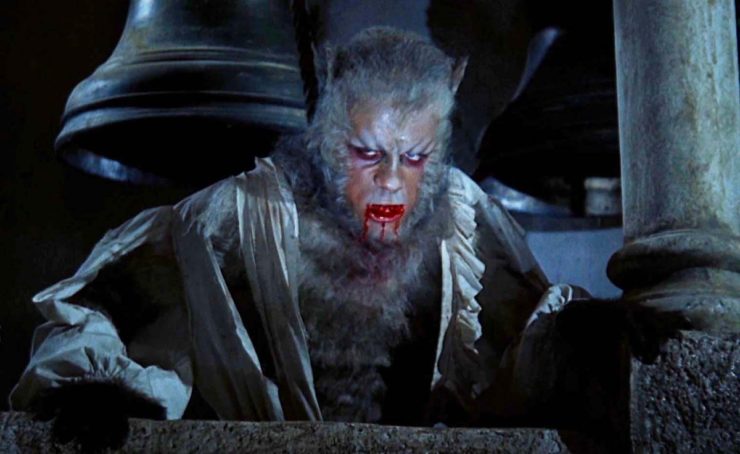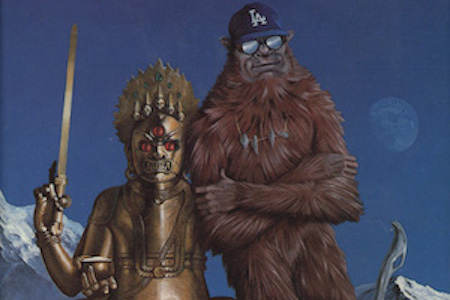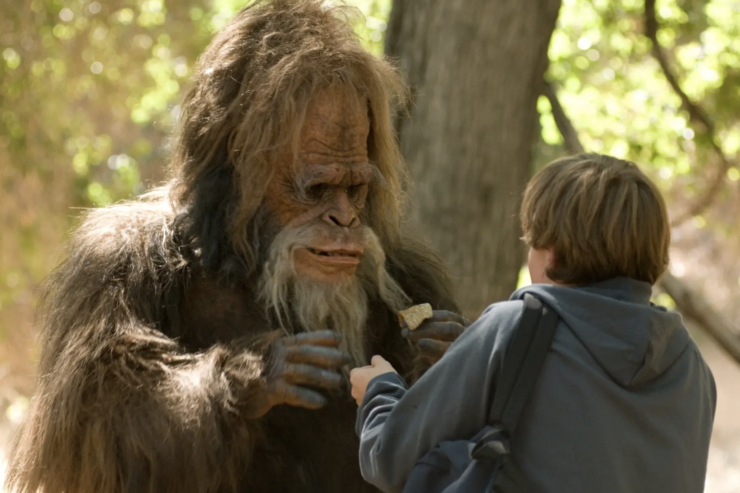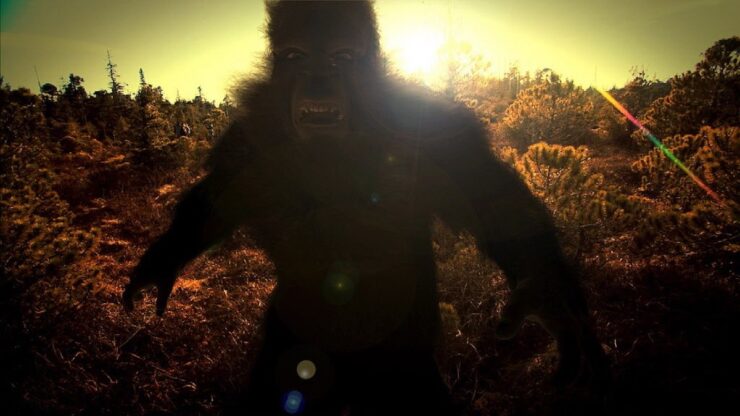David, the protagonist of An American Werewolf in London, is somewhat of a Lon Chaney, Jr superfan. He cites The Wolf Man more than once, and is careful to distinguish it from a later work, “the one with Oliver Reed.” He’s referring to the 1961 Hammer film, The Curse of the Werewolf.
In the early ’80s, Reed had been a huge star for over a decade, with a swelling roster of roles and a reputation for hard drinking, hard fighting, and overall hard living. But before he was a star, he appeared in a strange little horror picture.
The Curse of the Werewolf is set in eighteenth-century Spain. Why Spain, no one ever explains. It seems to be a sort of fairy-tale land, populated by sumptuously costumed people of various classes, and one token, miserably attired beggar.
The story begins with the beggar’s arrival in the town of Santa Vera, where the church bells are ringing and the streets are empty though it’s not a Sunday. He learns from the patrons of a remarkably clean and sanitized tavern that it’s a public holiday: the Marqués is getting married, and the people of the town have been taxed to pay for it. They don’t have anything left to give him, but they urge him to trek up to the castle and beg for the Marqués’ charity.
The beggar finds the Marqués and his court to be cruel and capricious, and the Marqués’ bride to be somewhat less so—at least she begs her new husband to feed the beggar, and is given him as a pet. He’s sent to be “cared for”—in the dungeon, where he’s locked up and forgotten, except by the jailer and his mute daughter, who feeds him.
Years pass. The daughter grows up. The Marquesa dies of cruelty and neglect. The Marqués becomes a recluse. And the beggar is still in the dungeon—until the day when the Marqués tries to assault his mute servant, and she fights him off. He flings her into the dungeon with the beggar, who by now is completely mad and very hairy.
The beggar attacks the girl, and dies for it. She’s dragged back to the Marqués, but this time she’s ready for him. She stabs him to death and escapes into the wild.
There she lives for months until Alfredo, the film’s narrator, finds her face down in a pool. Together with his servant Teresa, he takes her in and cares for her. It’s Teresa who informs him that the girl is pregnant.
By now it’s nearly Christmas, and Teresa hopes the child won’t be born on the same day as Jesus. It’s an insult to heaven, she says, for a baby with such a history to share a birthday with the son of God. She does everything she can to prevent this from happening, but of course she fails. The jailer’s daughter delivers a healthy boy on Christmas and promptly dies.
Alfredo adopts the child and names him Leon. There are portents at his baptism: darkness and thunder and shaking of the font. But the priest manages to get the job done, for whatever good it will do later.
When Leon is about seven years old, animals begin to turn up dead with throats ripped out and blood drained from their bodies. It doesn’t take Alfredo and Teresa long to connect the killings with Leon, with the help of the parish priest, who speaks to them of spirits that will try to occupy the body of any human who is weak or compromised in some way—by, for example, being born out of wedlock. Sometimes such a spirit will be that of a wolf, and the possessed human becomes a werewolf.
But, says the priest, if this happens, all is not lost. The cure for the curse is love. The werewolf must find a woman who will love him wholeheartedly. Then he’ll be saved.
Leon grows into a handsome, strapping young man who is determined to make his own way in the world. (Young Oliver Reed was really something. Dark. Brooding. Chiseled. And oh, those blue, blue eyes.) He finds work at a nearby vineyard, makes friends with his coworker, Jose, and immediately falls in love with a rich man’s daughter—Cristina, who is engaged to the son of the man who owns the vineyard.
Cristina is anything but pleased with the engagement, and is as strongly attracted to Leon as he is to her. He begs her to run away and marry him, but she refuses. Her father will never allow it.
When Saturday comes around, Jose persuades Leon to accompany him to a “respectable” establishment on the outskirts of town. Leon has little interest in either the drink or the entertainment. The moon is full, and now he’s left his family, he has no one to protect him from it.
One of the girls at the brothel invites him to her room, with intentions that are clear to us, but maybe not to Leon. The moon overwhelms him there. When next the picture clears, there is blood on the walls and a woman dead on the floor, and Jose, who has come looking for his friend, meets something much more deadly instead.
Alfredo finds Leon naked in his old bed, with no memory of what happened. It’s clear how he got in: the bars on the window that used to keep him contained are bent and twisted. There’s blood on his hands; he doesn’t know whose, but he knows enough to be utterly horrified. He runs away into the hills, and ends up back at the vineyard.
There he learns that three people are dead. He shuts himself in a cellar, where Cristina finds him. She spends the night there, giving him chaste comfort, and when morning comes, he’s still in human form. She’s kept him safe. Again he begs her to run away and marry him, and this time she agrees. She still doesn’t know why he’s so desperate, or what he really is, but she is sincerely smitten.
The next day he’s arrested and imprisoned for murder. He asks his jailers to send for his father; when Alfredo and the priest come, he asks them to take him to the mayor, to whom he makes a full confession. He begs the mayor to arrest and confine him, and to burn him alive before the sun goes down, or there will be another night of blood and murder.
It seems he’s forgotten about Cristina, or is so shattered by the murder charges that he can’t think about redemption. He doesn’t know that her father caught her trying to leave, or that she’s commandeered her ex-fiance’s carriage and is coming to find him.
The mayor is too slow and too intent on procedure, on proof and witnesses, to execute Leon as he asks. The priest prefers another option: Leon should be sent to a monastery and confined there, watched over by day and night. No one reaches a resolution, and night is coming. Leon is locked up in the town jail, but not securely enough—he isn’t chained.
Buy the Book
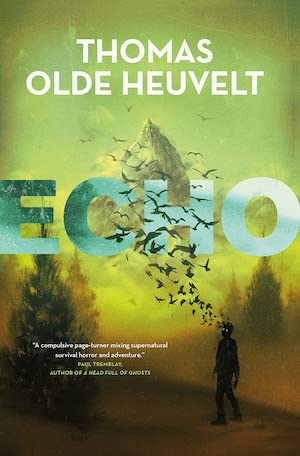

Echo
When the moon rises, Leon transforms into a werewolf. He kills his cellmate, breaks down the gate, and escapes into the town.
The town is ready for him, with a mob and torches. He heads for the heights, climbing up the walls until eventually he comes to the bell tower of the church.
By then Cristina has arrived and been taken in by Alfredo and Teresa; there she finds out what her would-be husband is, which throws her into shock. Alfredo meanwhile has taken steps of his own, since the mayor won’t execute Leon by burning. There is a silver bullet, forged years ago by old Pepe who guards the village goats, to take down the wolf that was attacking the flock. Alfredo goes to find Pepe and retrieve the bullet.
Father and adopted son meet in the bell tower. Alfredo does what he has to do, out of love. The bullet finds its target. The curse is ended.
This is a strange, dark story, with strong sexual themes for 1961. There’s rape and sexual assault; there’s no doubt what’s happening with the prostitute on Saturday night. Leon never really has any hope of escaping the curse. As long as he’s closely monitored by his adoptive family, he seems to be cured, but once he goes out on his own, the first full moon brings back the curse in full force.
It’s a cruel thing, that curse. It dooms him from birth, for being conceived of rape and born on the wrong day. Love saves him, but only temporarily. In the end, there’s only one thing to be done, and Alfredo does it—with Leon’s consent, while he’s capable of giving it.
Here we have some of the key themes of the werewolf genre, but with a twist. The intrinsic curse—no werewolf bite here; Leon is born this way. The silver bullet—forged from a cross, here (the film says crucifix, but there’s no Christ on the cross; it’s pure plain silver). The transformation that stops halfway, with the human form still clear to see underneath the hair and the fangs and the claws. The idea that love can save the victim from the curse. But this is horror, and in horror, the curse wins.
Judith Tarr is a lifelong horse person. She supports her habit by writing works of fantasy and science fiction as well as historical novels, many of which have been published as ebooks. She’s written a primer for writers who want to write about horses: Writing Horses: The Fine Art of Getting It Right. She lives near Tucson, Arizona with a herd of Lipizzans, a clowder of cats, and a blue-eyed dog.










